Zinc–Cobalt Oxide Thin Films: High Curie Temperature Studied by Electron Magnetic Resonance
Abstract
:1. Introduction
2. Results and Discussion
3. Materials and Methods
4. Conclusions
Supplementary Materials
Author Contributions
Funding
Institutional Review Board Statement
Informed Consent Statement
Data Availability Statement
Conflicts of Interest
Sample Availability
References
- Pearton, S. GaN and ZnO-Based Materials and Devices; Pearton, S., Ed.; Springer Series in Materials Science; Springer: Berlin/Heidelberg, Germany, 2012; Volume 156, ISBN 978-3-642-23520-7. [Google Scholar]
- Weng, J.; Zhang, Y.; Han, G.; Zhang, Y.; Xu, L.; Xu, J.; Huang, X.; Chen, K. Electrochemical deposition and characterization of wide band semiconductor ZnO thin film. Thin Solid Films 2005, 478, 25–29. [Google Scholar] [CrossRef]
- Wilkinson, J.; Ucer, K.B.; Williams, R.T. Picosecond excitonic luminescence in ZnO and other wide-gap semiconductors. Radiat. Meas. 2004, 38, 501–505. [Google Scholar] [CrossRef]
- Greuter, F. ZnO Varistors: From Grain Boundaries to Power Applications. In Oxide Electronics; John Wiley & Sons, Ltd.: Hoboken, NJ, USA, 2021; pp. 157–234. [Google Scholar]
- Tsai, Y.T.; Chang, S.J.; Ji, L.W.; Hsiao, Y.J.; Tang, I.T.; Lu, H.Y.; Chu, Y.L. High Sensitivity of NO Gas Sensors Based on Novel Ag-Doped ZnO Nanoflowers Enhanced with a UV Light-Emitting Diode. ACS Omega 2018, 3, 13798–13807. [Google Scholar] [CrossRef] [Green Version]
- Kang, Y.; Yu, F.; Zhang, L.; Wang, W.; Chen, L.; Li, Y. Review of ZnO-based nanomaterials in gas sensors. Solid State Ion. 2021, 360, 115544. [Google Scholar] [CrossRef]
- Kolesnik, S.; Dabrowski, B.; Mais, J. Structural and magnetic properties of transition metal substituted ZnO. J. Appl. Phys. 2004, 95, 2582–2586. [Google Scholar] [CrossRef] [Green Version]
- Samarth, N.; Furdyna, J.K. Electron paramagnetic resonance in Cd1−xMnxS, Cd1−xMnxSe, and Cd1−xMnxTe. Phys. Rev. B 1988, 37, 9227–9239. [Google Scholar] [CrossRef]
- Volbers, N.; Zhou, H.; Knies, C.; Pfisterer, D.; Sann, J.; Hofmann, D.M.; Meyer, B.K. Synthesis and characterization of ZnO:Co2+ nanoparticles. Appl. Phys. A Mater. Sci. Process. 2007, 88, 153–155. [Google Scholar] [CrossRef]
- Awschalon, D.D.; Loss, D. Semiconductors Spintronics and Quantum Computation; Springer: Berlin/Heidelberg, Germany, 2002; ISBN 9783642075773. [Google Scholar]
- Pearton, S.J.; Norton, D.P.; Heo, Y.W.; Tien, L.C.; Ivill, M.P.; Li, Y.; Kang, B.S.; Ren, F.; Kelly, J.; Hebard, A.F. ZnO spintronics and nanowire devices. J. Electron. Mater. 2006, 35, 862–868. [Google Scholar] [CrossRef]
- Pan, F.; Song, C.; Liu, X.J.; Yang, Y.C.; Zeng, F. Ferromagnetism and possible application in spintronics of transition-metal-doped ZnO films. Mater. Sci. Eng. R Rep. 2008, 62, 1–35. [Google Scholar] [CrossRef]
- Kisan, B.; Kumar, J.; Alagarsamy, P. Experimental and first-principles study of defect-induced electronic and magnetic properties of ZnO nanocrystals. J. Phys. Chem. Solids 2020, 146, 109580. [Google Scholar] [CrossRef]
- Dietl, T.; Ohno, H.; Matsukura, F.; Cibert, J.; Ferrand, D. Zener Model Description of Ferromagnetism in Zinc-Blende Magnetic Semiconductors. Science 2000, 287, 1019–1022. [Google Scholar] [CrossRef] [PubMed] [Green Version]
- Sato, K.; Katayama-Yoshida, H. Material design for transparent ferromagnets with ZnO-based magnetic semiconductors. Jpn. J. Appl. Phys. Part 2 Lett. 2000, 39, L555–L558. [Google Scholar] [CrossRef]
- Sato, K.; Katayama-Yoshida, H. Stabilization of ferromagnetic states by electron doping in Fe-, Co- or Ni-doped ZnO. Jpn. J. Appl. Phys. Part 2 Lett. 2001, 40, L334–L336. [Google Scholar] [CrossRef]
- Jung, S.W.; An, S.-J.; Yi, G.-C.; Jung, C.U.; Lee, S.-I.; Cho, S. Ferromagnetic properties of Zn1−xMnxO epitaxial thin films. Appl. Phys. Lett. 2002, 80, 4561–4563. [Google Scholar] [CrossRef] [Green Version]
- Schwartz, D.A.; Norberg, N.S.; Nguyen, Q.P.; Parker, J.M.; Gamelin, D.R. Magnetic Quantum Dots: Synthesis, Spectroscopy, and Magnetism of Co2+- and Ni2+-Doped ZnO Nanocrystals. J. Am. Chem. Soc. 2003, 125, 13205–13218. [Google Scholar] [CrossRef] [PubMed]
- Lee, H.-J.; Jeong, S.-Y.; Cho, C.R.; Park, C.H. Study of diluted magnetic semiconductor: Co-doped ZnO. Appl. Phys. Lett. 2002, 81, 4020–4022. [Google Scholar] [CrossRef] [Green Version]
- Cho, Y.M.; Choo, W.K.; Kim, H.; Kim, D.; Ihm, Y. Effects of rapid thermal annealing on the ferromagnetic properties of sputtered Zn1−x(Co0.5Fe0.5)xO thin films. Appl. Phys. Lett. 2002, 80, 3358–3360. [Google Scholar] [CrossRef]
- Sharma, P.; Gupta, A.; Rao, K.V.; Owens, F.J.; Sharma, R.; Ahuja, R.; Osorio-Guillen, J.M.; Johansson, B.; Gehring, G.A. Ferromagnetism above room temperature in bulk and transparent thin films of Mn-doped ZnO. Nat. Mater. 2003, 2, 673–677. [Google Scholar] [CrossRef]
- Wakano, T.; Fujimura, N.; Morinaga, Y.; Abe, N.; Ashida, A.; Ito, T. Magnetic and magneto-transport properties of ZnO:Ni films. Phys. E 2001, 10, 260–264. [Google Scholar] [CrossRef]
- Ueda, K.; Tabata, H.; Kawai, T. Magnetic and electric properties of transition-metal-doped ZnO films. Appl. Phys. Lett. 2001, 79, 988–990. [Google Scholar] [CrossRef]
- Kim, J.H.; Kim, H.; Kim, D.; Ihm, Y.E.; Choo, W.K. Magnetic properties of epitaxially grown semiconducting Zn 1−xCoxO thin films by pulsed laser deposition. J. Appl. Phys. 2002, 92, 6066–6071. [Google Scholar] [CrossRef]
- Ankiewicz, A.O.; Carmo, M.C.; Sobolev, N.A.; Gehlhoff, W.; Kaidashev, E.M.; Rahm, A.; Lorenz, M.; Grundmann, M. Electron paramagnetic resonance in transition metal-doped ZnO nanowires. J. Appl. Phys. 2007, 101, 024324. [Google Scholar] [CrossRef]
- Jalbout, A.F.; Chen, H.; Whittenburg, S.L. Monte Carlo simulation on the indirect exchange interactions of Co-doped ZnO film. Appl. Phys. Lett. 2002, 81, 2217–2219. [Google Scholar] [CrossRef] [Green Version]
- Lee, E.C.; Chang, K.J.J. Ferromagnetic versus antiferromagnetic interaction in Co-doped ZnO. Phys. Rev. B-Condens. Matter Mater. Phys. 2004, 69, 085205. [Google Scholar] [CrossRef]
- Merga, G.; Cass, L.C.; Chipman, D.M.; Meisel, D. Probing silver nanoparticles during catalytic H2 evolution. J. Am. Chem. Soc. 2008, 130, 7067–7076. [Google Scholar] [CrossRef] [PubMed]
- Choi, J.S.; Jun, Y.W.; Yeon, S.I.; Kim, H.C.; Shin, J.S.; Cheon, J. Biocompatible heterostructured nanoparticles for multimodal biological detection. J. Am. Chem. Soc. 2006, 128, 15982–15983. [Google Scholar] [CrossRef]
- Jeong, S.H.; Park, B.N.; Lee, S.B.; Boo, J.-H. Structural and optical properties of silver-doped zinc oxide sputtered films. Surf. Coat. Technol. 2005, 193, 340–344. [Google Scholar] [CrossRef]
- Gouvêa, C.A.K.; Wypych, F.; Moraes, S.G.; Durán, N.; Peralta-Zamora, P. Semiconductor-assisted photodegradation of lignin, dye, and kraft effluent by Ag-doped ZnO. Chemosphere 2000, 40, 427–432. [Google Scholar] [CrossRef]
- Georgekutty, R.; Seery, M.K.; Pillai, S.C. A highly efficient Ag-ZnO photocatalyst: Synthesis, properties, and mechanism. J. Phys. Chem. C 2008, 112, 13563–13570. [Google Scholar] [CrossRef] [Green Version]
- Yin, X.; Que, W.; Fei, D.; Shen, F.; Guo, Q. Ag nanoparticle/ZnO nanorods nanocomposites derived by a seed-mediated method and their photocatalytic properties. J. Alloys Compd. 2012, 524, 13–21. [Google Scholar] [CrossRef]
- Wang, J.; Fan, X.M.; Tian, K.; Zhou, Z.W.; Wang, Y. Largely improved photocatalytic properties of Ag/tetrapod-like ZnO nanocompounds prepared with different PEG contents. Appl. Surf. Sci. 2011, 257, 7763–7770. [Google Scholar] [CrossRef]
- Zheng, Y.; Zheng, L.; Zhan, Y.; Lin, X.; Zheng, Q.; Wei, K. Ag/ZnO heterostructure nanocrystals: Synthesis, characterization, and photocatalysis. Inorg. Chem. 2007, 46, 6980–6986. [Google Scholar] [CrossRef] [PubMed]
- Lin, D.; Wu, H.; Zhang, R.; Pan, W. Enhanced photocatalysis of electrospun Ag-ZnO heterostructured nanofibers. Chem. Mater. 2009, 21, 3479–3484. [Google Scholar] [CrossRef]
- Zhang, D.; Liu, X.; Wang, X. Growth and photocatalytic activity of ZnO nanosheets stabilized by Ag nanoparticles. J. Alloys Compd. 2011, 509, 4972–4977. [Google Scholar] [CrossRef]
- Hu, H.; Wang, Z.; Wang, S.; Zhang, F.; Zhao, S.; Zhu, S. ZnO/Ag heterogeneous structure nanoarrays: Photocatalytic synthesis and used as substrate for surface-enhanced Raman scattering detection. J. Alloys Compd. 2011, 509, 2016–2020. [Google Scholar] [CrossRef]
- Aguirre, M.E.; Rodríguez, H.B.; San Román, E.; Feldhoff, A.; Grela, M.A. Ag@ZnO Core–Shell Nanoparticles Formed by the Timely Reduction of Ag+ Ions and Zinc Acetate Hydrolysis in N,N-Dimethylformamide: Mechanism of Growth and Photocatalytic Properties. J. Phys. Chem. C 2011, 115, 24967–24974. [Google Scholar] [CrossRef]
- Wang, C.C.; Shieu, F.S.; Shih, H.C. Ag-nanoparticle enhanced photodegradation of ZnO nanostructures: Investigation using photoluminescence and ESR studies. J. Environ. Chem. Eng. 2021, 9, 104707. [Google Scholar] [CrossRef]
- Yan, Y.; Al-Jassim, M.M.; Wei, S.H. Doping of ZnO by group-IB elements. Appl. Phys. Lett. 2006, 89, 181912. [Google Scholar] [CrossRef]
- Ahn, B.D.; Kang, H.S.; Kim, J.H.; Kim, G.H.; Chang, H.W.; Lee, S.Y. Synthesis and analysis of Ag-doped ZnO. J. Appl. Phys. 2006, 100, 093701. [Google Scholar] [CrossRef]
- Brauer, G.; Kuriplach, J.; Ling, C.C.; Djurišić, A.B. Activities towards p-type doping of ZnO. J. Phys. Conf. Ser. 2011, 265, 012002. [Google Scholar] [CrossRef]
- Srinivasu, V.V.; Lofland, S.E.; Bhagat, S.M.; Ghosh, K.; Tyagi, S.D. Temperature and field dependence of microwave losses in manganite powders. J. Appl. Phys. 1999, 86, 1067–1072. [Google Scholar] [CrossRef]
- Alvarez, G.; Zamorano, R. Characteristics of the magnetosensitive non-resonant power absorption of microwave by magnetic materials. J. Alloys Compd. 2004, 369, 231–234. [Google Scholar] [CrossRef]
- Montiel, H.; Alvarez, G.; Betancourt, I.; Zamorano, R.; Valenzuela, R. Correlations between low-field microwave absorption and magnetoimpedance in Co-based amorphous ribbons. Appl. Phys. Lett. 2005, 86, 072503. [Google Scholar] [CrossRef]
- Stefaniuk, I.; Cieniek, B.; Virt, I.S. Magnetic Properties of Zinc-Oxide Composite Doped with Transition Metal Ions (Mn, Co, Cr). Curr. Top. Biophys. 2010, 33, 221–226. [Google Scholar]
- Cieniek, B.; Stefaniuk, I.; Virt, I.S. EPR study of ZnO:Co thin films grown by the PLD method. Nukleonika 2013, 58, 359–363. [Google Scholar]
- Cieniek, B.; Stefaniuk, I.; Virt, I.S. EMR spectra thin films doped with high concentration of Co and Cr on quartz and sapphire substrates. Acta Phys. Pol. A 2017, 132, 30–33. [Google Scholar] [CrossRef]
- Mozurkewich, G.; Elliott, J.H.; Hardiman, M.; Orbach, R. Exchange-narrowed anisotropy contribution to the EPR width and shift in the Ag-Mn spin-glass. Phys. Rev. B 1984, 29, 278–287. [Google Scholar] [CrossRef]
- Long, S.M.; Zhou, P.; Miller, J.S.; Epstein, A.J. Electron Spin Resonance Study of The Disorder in The V(TCNE)x.y(MeCN) High-Tc Molecule-Based Magnet. Mol. Cryst. Liq. Cryst. Sci. Technol. Sect. A Mol. Cryst. Liq. Cryst. 1995, 272, 207–215. [Google Scholar] [CrossRef]
- Yildiz, F.; Yalçm, O.; Özdemir, M.; Aktaş, B.; Köseoǧlu, Y.; Jiang, J.S. Magnetic properties of Sm-Co/Fe exchange spring magnets. J. Magn. Magn. Mater. 2004, 272, E1941–E1942. [Google Scholar] [CrossRef]
- Yaln, O. Ferromagnetic Resonance. In Ferromagnetic Resonance-Theory and Applications; IntechOpen: London, UK, 2013; ISBN 978-953-51-1186-3. [Google Scholar]
- Mandal, A.R.; Mandal, S.K. Electron spin resonance in silver-doped PbS nanorods. J. Exp. Nanosci. 2010, 5, 189–198. [Google Scholar] [CrossRef]
- Becker, K.W. Theory of electron-spin-resonance linewidth and line-shift effects in spin-glasses with anisotropy and zero remanent magnetization. Phys. Rev. B 1982, 26, 2409–2413. [Google Scholar] [CrossRef]
- Huber, D.L. EPR linewidths in RbMnF3 and MnF2. Phys. Lett. A 1971, 37, 283–284. [Google Scholar] [CrossRef]
- Zomack, M.; Baberschke, K.; Barnes, S.E. Magnetic resonance in the spin-glass (LaGd)Al2. Phys. Rev. B 1983, 27, 4135–4148. [Google Scholar] [CrossRef]
- Yeomans, J.M. Statistical Mechanics of Phase Transitions; Clarendon Press: Oxford, UK, 1992; Volume 19, ISBN 9780198517306. [Google Scholar]
- Bhat, S.V.; Ramakrishnan, T.V.; Ganguly, P.; Rao, C.N.R. Absorption of electromagnetic radiation by superconducting YBa2Cu3O7: An oxygen-induced phenomenon. J. Phys. C Solid State Phys. 1987, 20, L559–L563. [Google Scholar] [CrossRef]
- Gafurov, M.R.; Kurkin, I.N.; Kurzin, S.P. Inhomogeneity of the intrinsic magnetic field in superconducting YBa2Cu3OX compounds as revealed by a rare-earth EPR probe. Supercond. Sci. Technol. 2005, 18, 1183–1189. [Google Scholar] [CrossRef] [Green Version]
- Savchuk, V.V.; Gamernyk, R.V.; Virt, I.S.; Malynych, S.Z.; Pinchuk, A.O. Plasmon-exciton coupling in nanostructured metal-semiconductor composite films. AIP Adv. 2019, 9, 045021. [Google Scholar] [CrossRef]
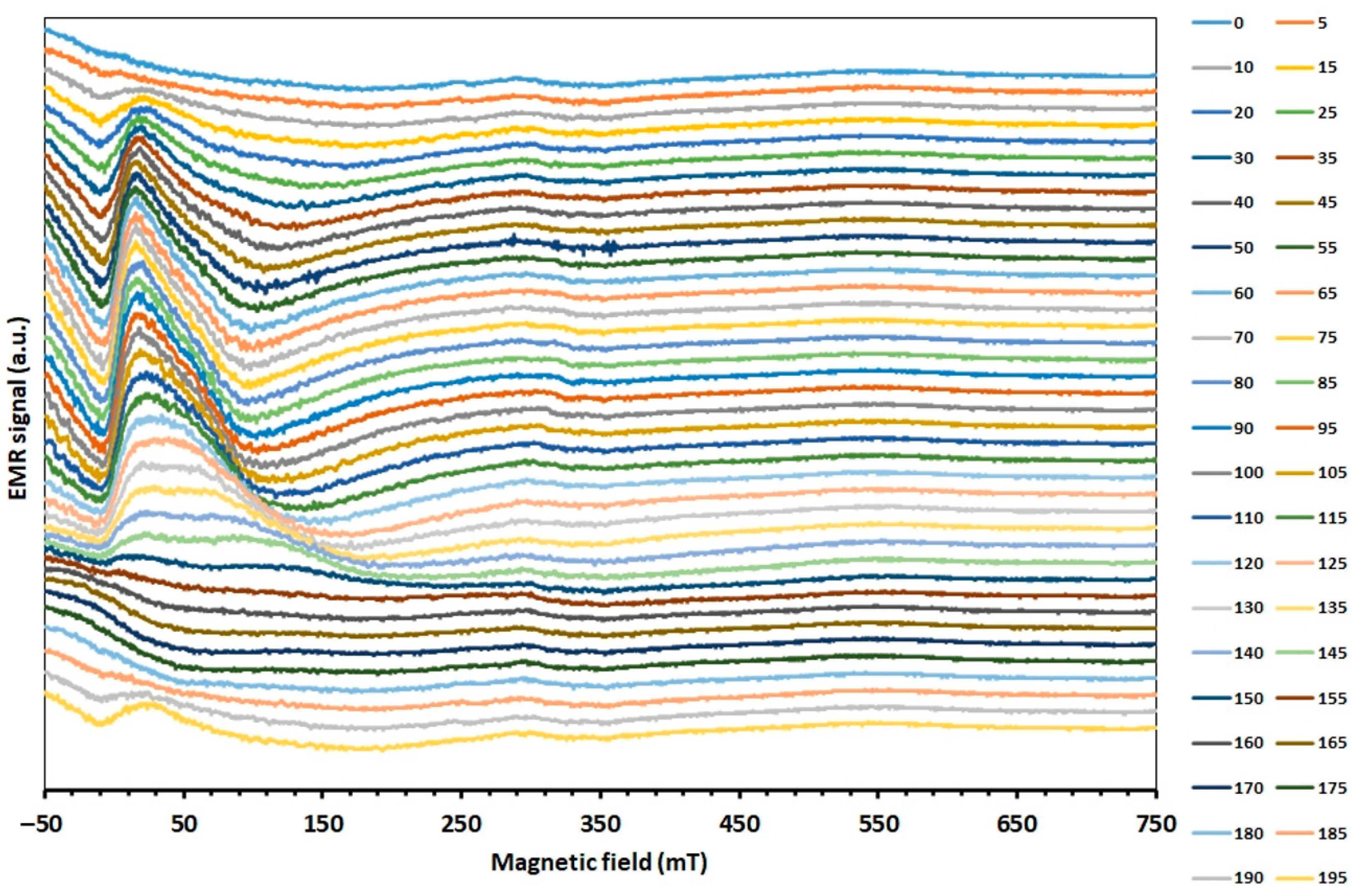

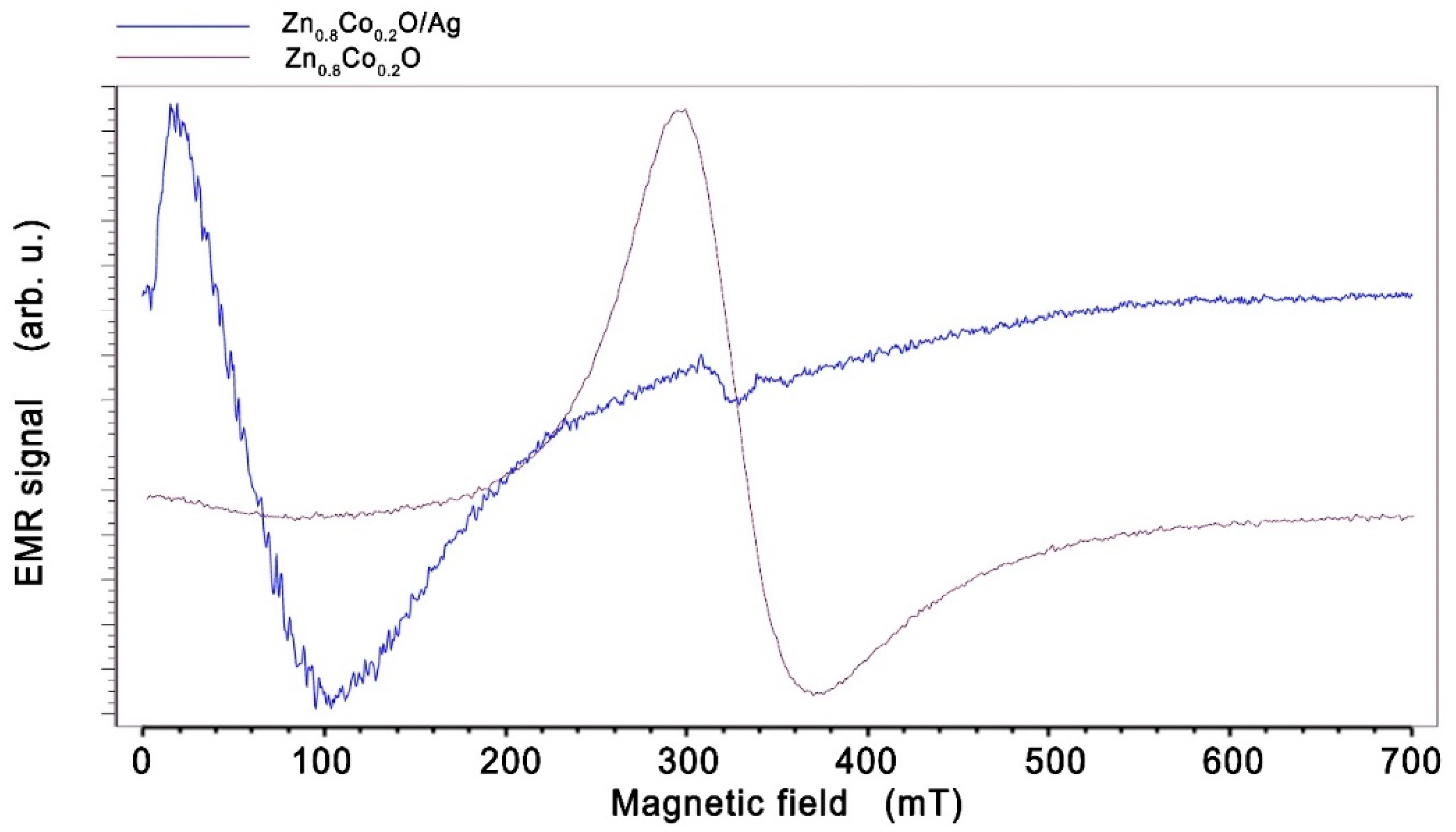
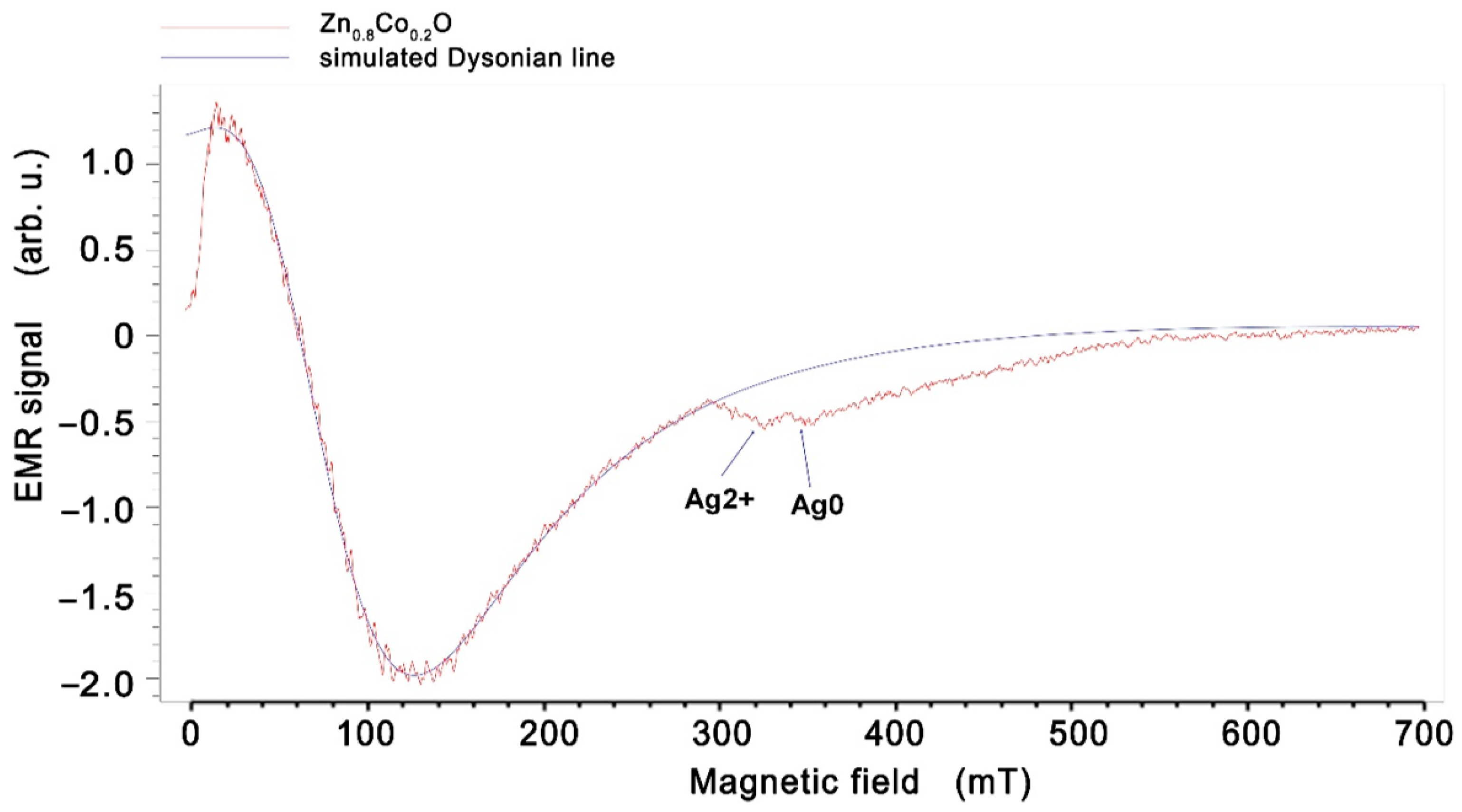
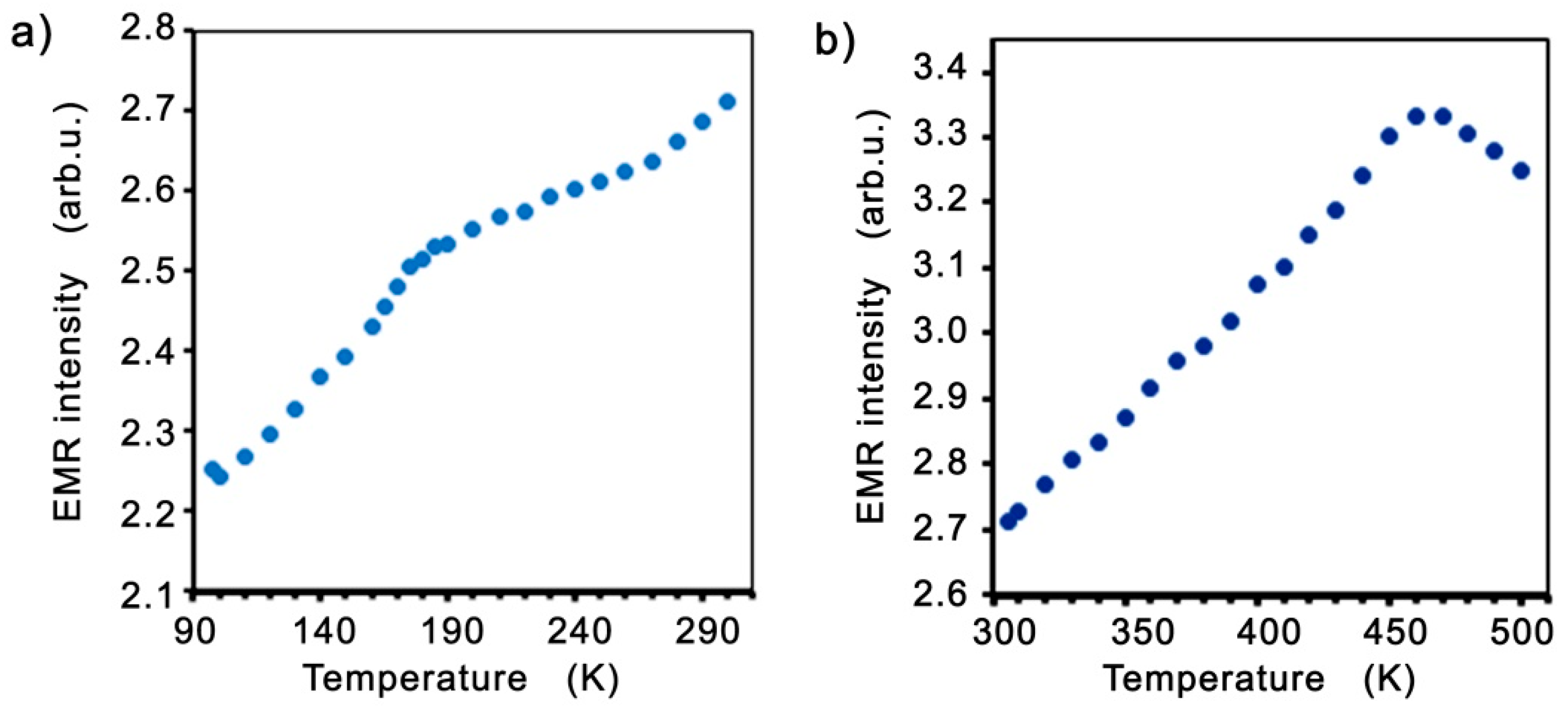

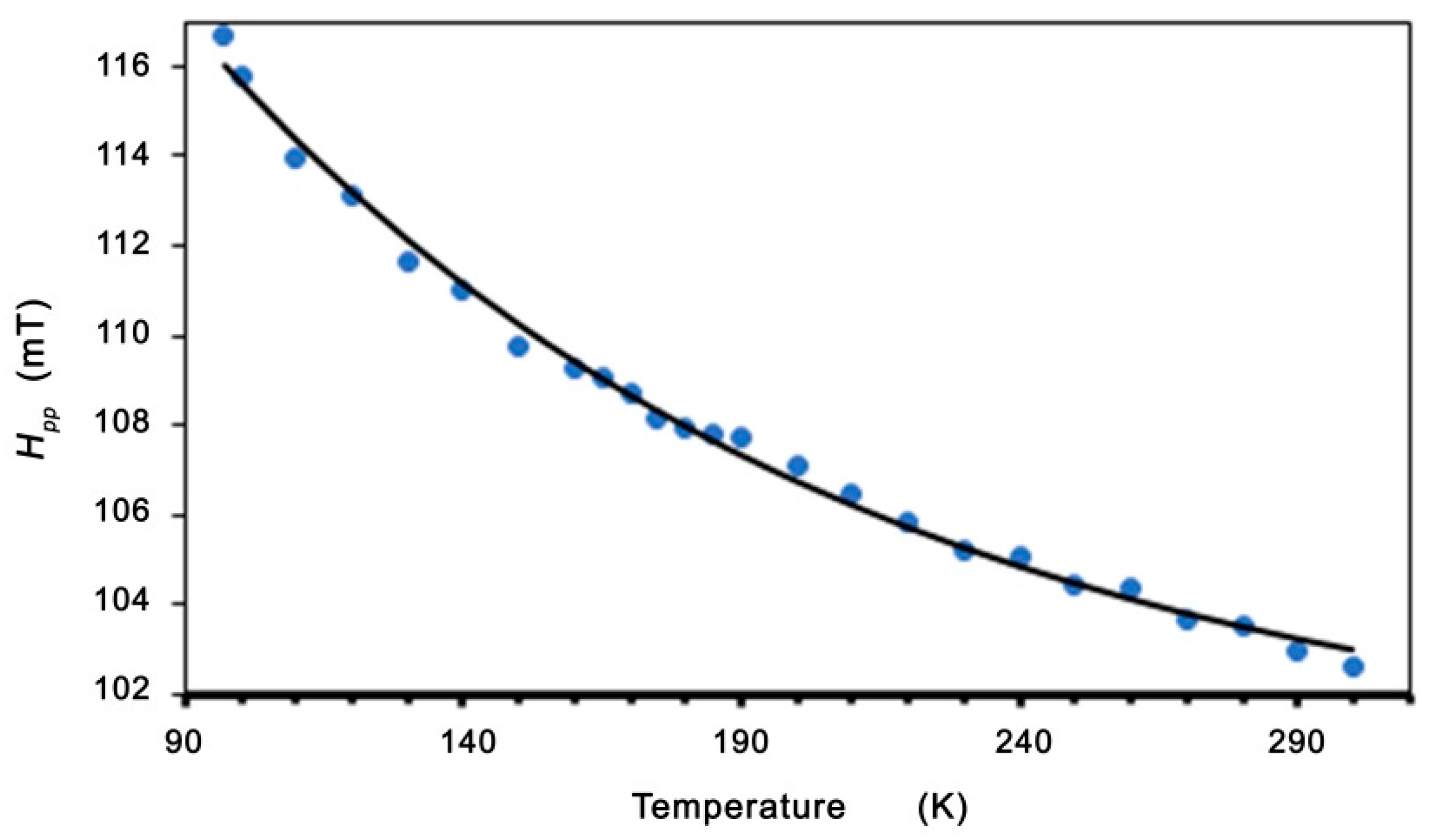
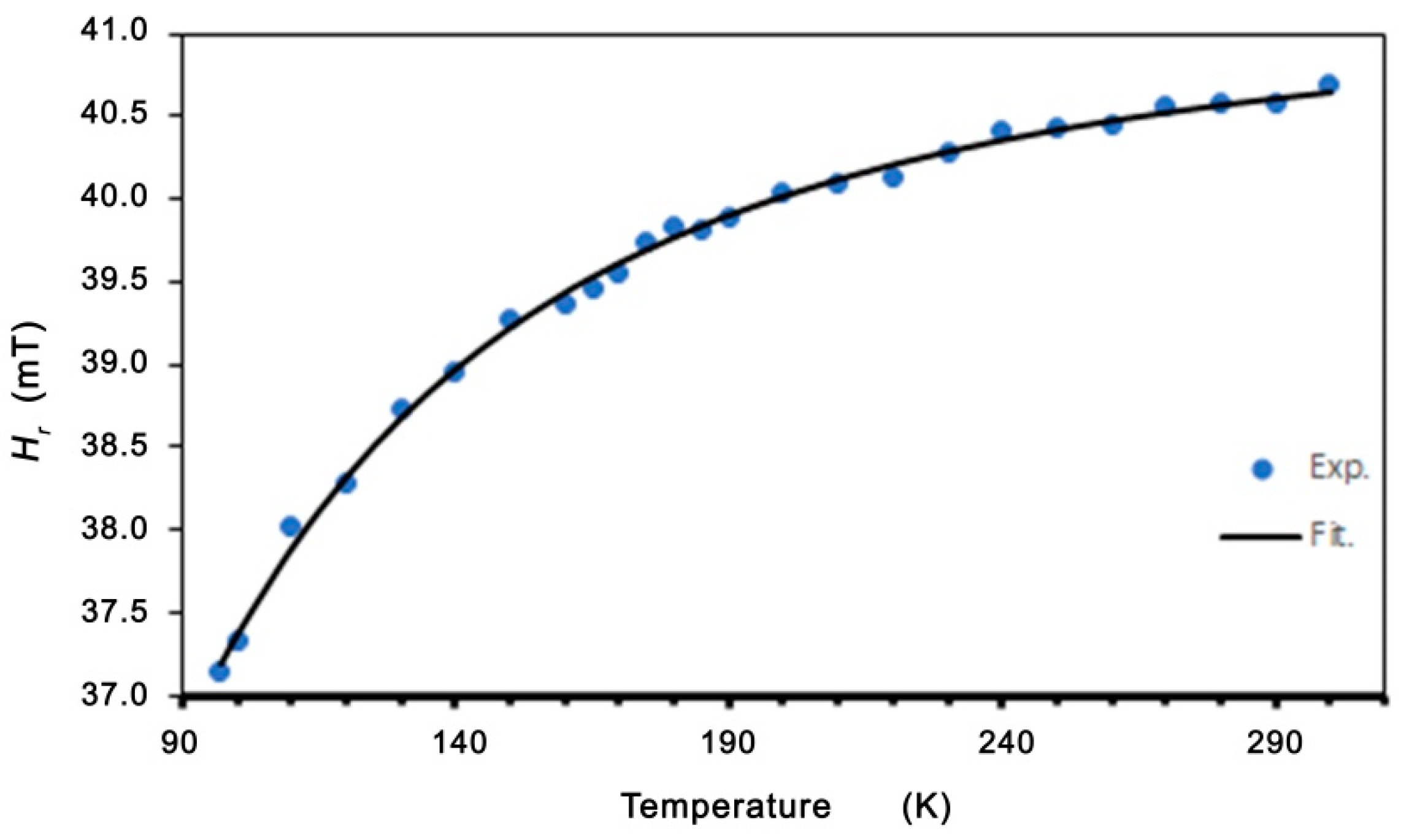
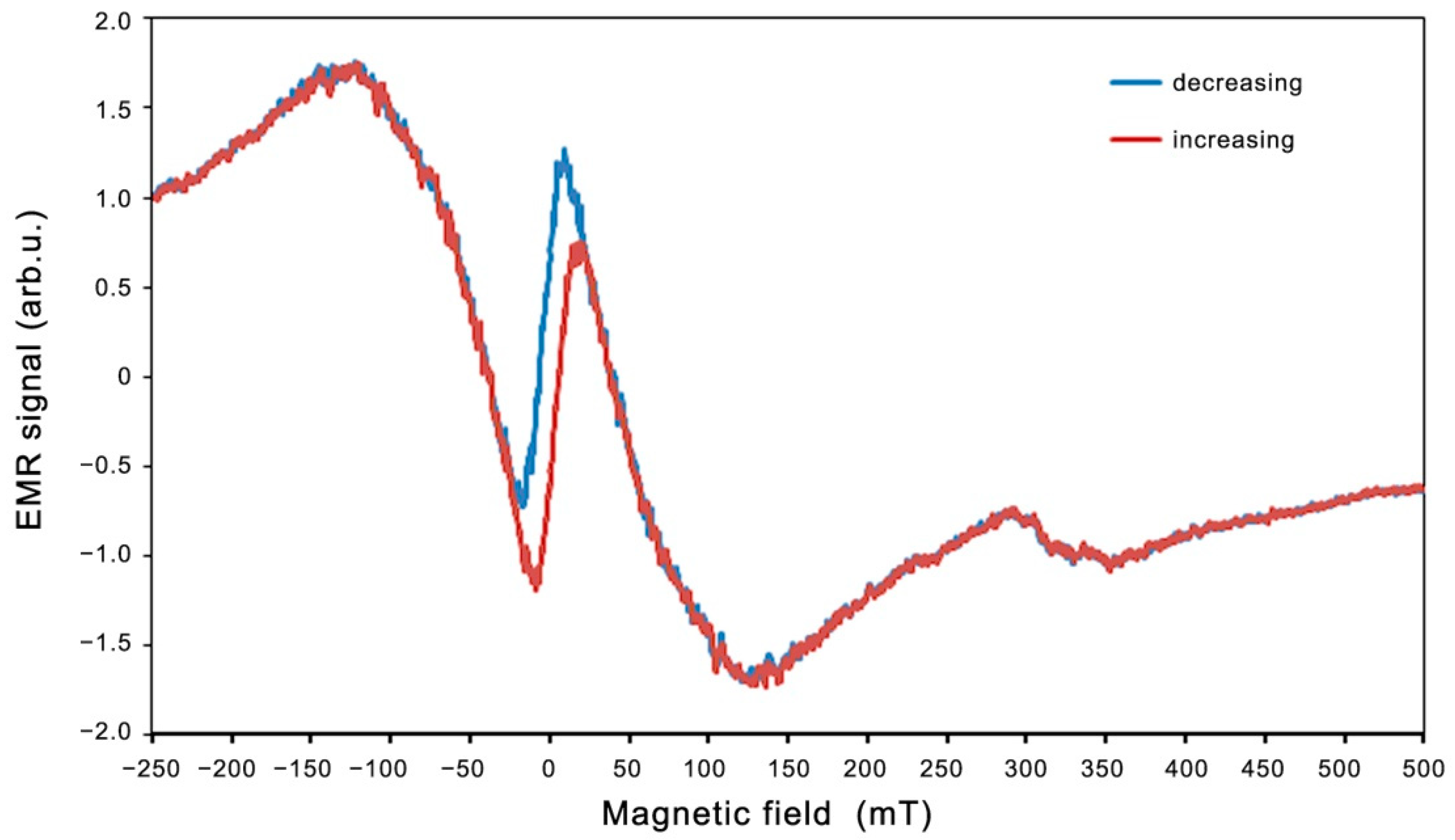
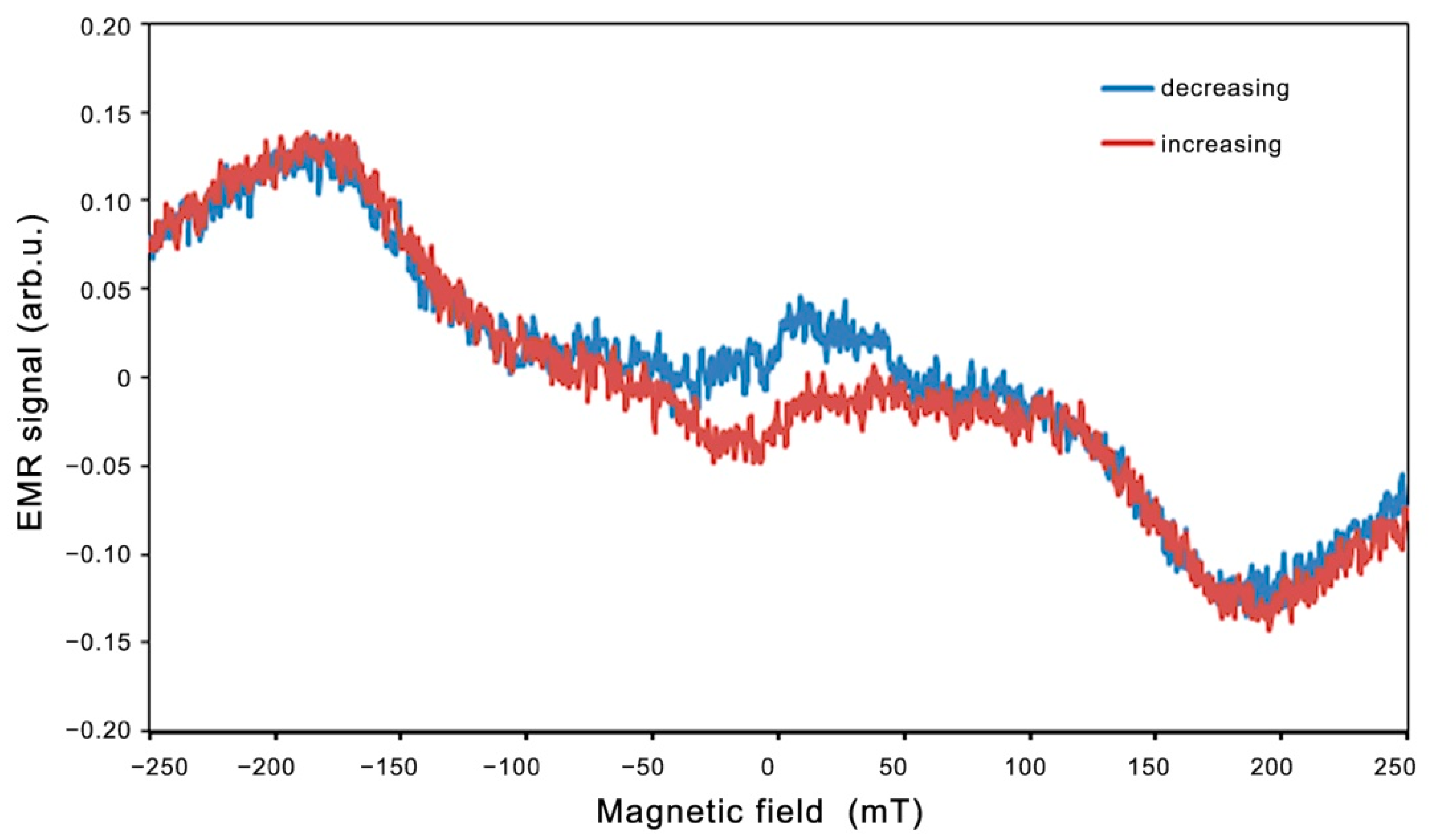
Publisher’s Note: MDPI stays neutral with regard to jurisdictional claims in published maps and institutional affiliations. |
© 2022 by the authors. Licensee MDPI, Basel, Switzerland. This article is an open access article distributed under the terms and conditions of the Creative Commons Attribution (CC BY) license (https://creativecommons.org/licenses/by/4.0/).
Share and Cite
Cieniek, B.; Stefaniuk, I.; Virt, I.; Gamernyk, R.V.; Rogalska, I. Zinc–Cobalt Oxide Thin Films: High Curie Temperature Studied by Electron Magnetic Resonance. Molecules 2022, 27, 8500. https://doi.org/10.3390/molecules27238500
Cieniek B, Stefaniuk I, Virt I, Gamernyk RV, Rogalska I. Zinc–Cobalt Oxide Thin Films: High Curie Temperature Studied by Electron Magnetic Resonance. Molecules. 2022; 27(23):8500. https://doi.org/10.3390/molecules27238500
Chicago/Turabian StyleCieniek, Bogumił, Ireneusz Stefaniuk, Ihor Virt, Roman V. Gamernyk, and Iwona Rogalska. 2022. "Zinc–Cobalt Oxide Thin Films: High Curie Temperature Studied by Electron Magnetic Resonance" Molecules 27, no. 23: 8500. https://doi.org/10.3390/molecules27238500
APA StyleCieniek, B., Stefaniuk, I., Virt, I., Gamernyk, R. V., & Rogalska, I. (2022). Zinc–Cobalt Oxide Thin Films: High Curie Temperature Studied by Electron Magnetic Resonance. Molecules, 27(23), 8500. https://doi.org/10.3390/molecules27238500








